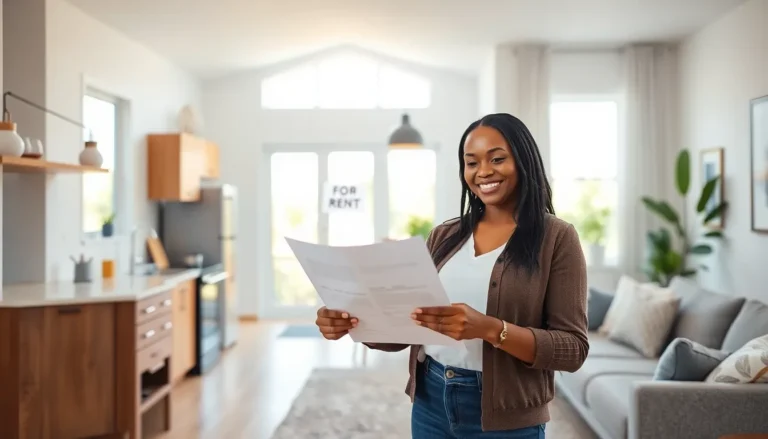Navigating the world of home leasing can feel like trying to assemble IKEA furniture without the instructions—frustrating and slightly terrifying. But fear not! This home leasing guide breaks it all down into bite-sized pieces, making it easier than ever to find your perfect nest without losing your sanity or your deposit.
Table of Contents
ToggleUnderstanding Home Leasing
Home leasing involves renting a property for a specified period. This arrangement allows individuals and families to live in a place without the long-term commitment of ownership.
What Is Home Leasing?
Home leasing refers to the contract between a landlord and tenant for property use. This agreement typically includes monthly rent and defines the duration of the lease. Leases can range from a few months to several years. Tenants acquire certain rights, such as maintaining privacy and accessing amenities. Understanding lease terms is essential for avoiding conflicts and ensuring satisfaction with the living situation.
Benefits of Home Leasing
Home leasing presents various advantages for tenants. Flexibility ranks high among these benefits, as it allows individuals to change locations based on lifestyle or job requirements. Cost-effectiveness also plays a critical role, as renting often requires less upfront investment than purchasing a home. Many leases include maintenance responsibilities handled by landlords, reducing tenants’ financial and time burdens. Access to amenities, such as pools or fitness centers, enhances the living experience. Additionally, leasing provides opportunities to explore different neighborhoods without the need for long-term commitment.
Finding the Right Home

Finding the right home requires careful consideration of budget and location. Both factors significantly impact tenant satisfaction.
Setting Your Budget
Define a budget before beginning a home search. Fixed expenses should include monthly rent, utilities, and any additional fees. In metropolitan areas, average rent ranges from $1,500 to $3,000 per month for a two-bedroom apartment. Prioritize needs such as parking and pet policies, as they influence rental costs. Avoid overspending by using online calculators to determine affordability based on income.
Researching Locations
Explore various neighborhoods to identify suitable options. Safety, accessibility, and proximity to work or school are essential factors. Online platforms provide insights into crime rates and community amenities, facilitating informed decisions. Gather feedback from residents to assess neighborhood livability. Commute times also play a vital role, influencing daily routines and convenience. Consider visiting areas during different times of day to get a complete picture of the environment.
The Leasing Process
The leasing process encompasses several essential steps for securing the right rental home. Understanding each step simplifies the journey significantly.
Viewing Properties
Viewing properties allows prospective tenants to assess living conditions firsthand. Attending scheduled open houses or private showings offers valuable insights into the property’s layout, features, and overall condition. During visits, individuals should evaluate vital aspects like natural light, storage space, and any potential maintenance issues. Noticing community features like nearby parks can enhance the living experience. Taking notes and comparing different properties aids in making informed decisions.
Application and Approval
Applying for a rental commonly involves submitting personal information and financial documentation. Most landlords or property managers require identification, employment verification, and rental history to evaluate applicants. Completing the application promptly ensures consideration, especially in competitive markets. Approval depends on credit history, income level, and references. Responding swiftly to requests for additional information often expedites the process. Some landlords may charge an application fee, which typically ranges from $30 to $100. Understanding these elements clarifies the application cycle.
Lease Agreements
Lease agreements play a crucial role in the home leasing process. Understanding these documents helps landlords and tenants establish clear expectations.
Key Components of a Lease
Each lease contains essential components that define the rental arrangement. Key elements include the names of the parties involved, the property address, and the lease term length. Monthly rent amount is specified along with details on payment methods. Security deposit requirements typically appear as well, often equal to one month’s rent. Additional aspects such as maintenance responsibilities and pet policies should also be clarified. Renters can better understand their obligations by reviewing these components closely.
Common Terms and Conditions
Common terms and conditions outline the mutual responsibilities of both parties. Tenants should note terms regarding lease termination, typically requiring a notice period of 30 days before moving out. Maintenance responsibilities often specify which repairs are the landlord’s duty and which fall to the tenant. Restrictions on activities, like noise levels or modifications to the property, are commonly included. Renters benefit from being familiar with these terms to ensure compliance and avoid potential disputes. Awareness of these provisions fosters a smoother rental experience.
Moving In and Managing Your Lease
This section provides essential insights for tenants starting their new rental journey. Understanding critical aspects ensures a successful transition into the new home.
Preparing for the Move
Planning ahead streamlines the moving process. Start by creating a checklist that includes tasks like scheduling utility transfers, changing the address, and packing belongings. Securing professional movers or renting a truck contributes to an efficient move. Gathering necessary documents, such as the lease agreement, helps maintain organized records during the transition. Applying for rental insurance protects valuables during the move. Confirming move-in dates with the landlord ensures a smooth handover. Finally, informing friends and family about the new address facilitates sending personal mail.
Communicating with Your Landlord
Effective communication fosters positive relationships. Reach out promptly regarding any issues or concerns during the tenancy. Establishing a preferred communication method, whether it’s email or phone, promotes clarity. Notifications about maintenance requests or urgent repairs should be documented. Regularly checking in after moving in builds rapport and yields a better living experience. It’s vital to understand landlord response times and processes for handling requests. Keeping an open line of communication encourages collaborative problem-solving and sets clear expectations, enhancing tenant satisfaction.
Navigating the home leasing process can be challenging but with the right information and preparation it becomes manageable. Understanding lease agreements and knowing what to expect can significantly enhance the rental experience. By prioritizing needs and budgeting effectively prospective tenants can find a home that meets their lifestyle without overspending.
Building a positive relationship with landlords through effective communication is key to a successful tenancy. Being proactive about maintenance and addressing concerns promptly fosters a collaborative environment. With these insights in hand individuals can confidently embark on their leasing journey and enjoy the flexibility that renting offers.








